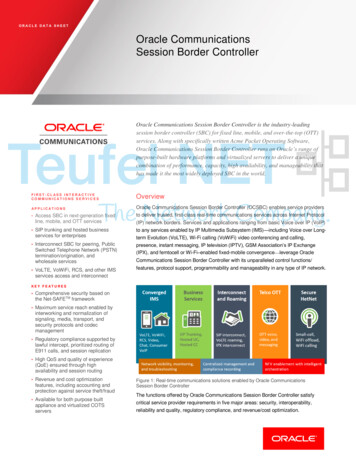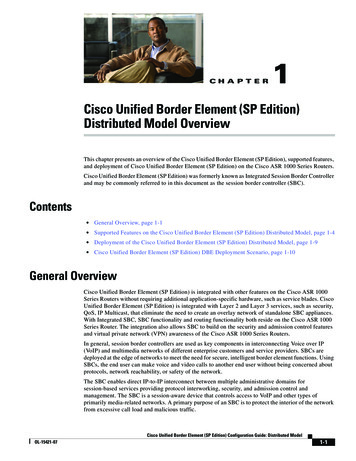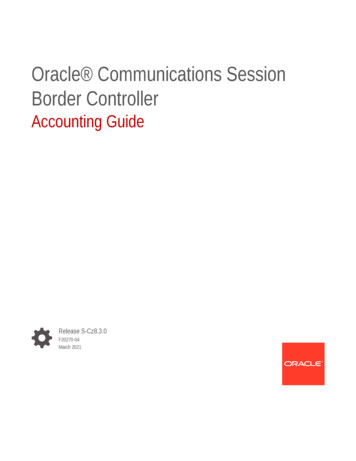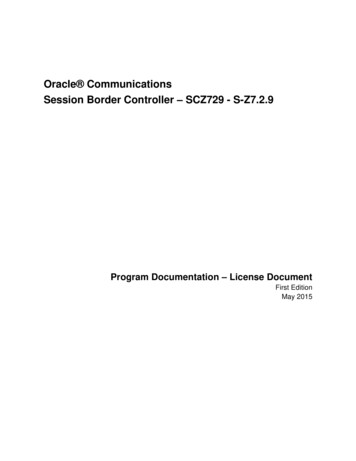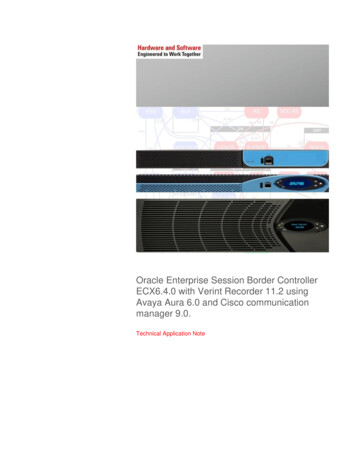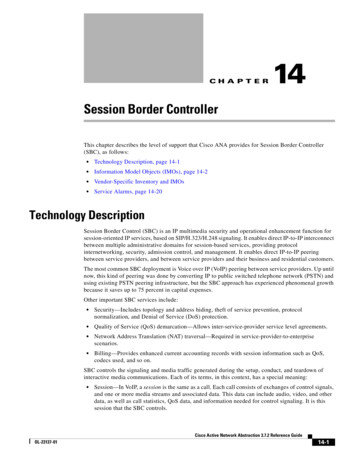
Transcription
CH A P T E R14Session Border ControllerThis chapter describes the level of support that Cisco ANA provides for Session Border Controller(SBC), as follows: Technology Description, page 14-1 Information Model Objects (IMOs), page 14-2 Vendor-Specific Inventory and IMOs Service Alarms, page 14-20Technology DescriptionSession Border Control (SBC) is an IP multimedia security and operational enhancement function forsession-oriented IP services, based on SIP/H.323/H.248 signaling. It enables direct IP-to-IP interconnectbetween multiple administrative domains for session-based services, providing protocolinternetworking, security, admission control, and management. It enables direct IP-to-IP peeringbetween service providers, and between service providers and their business and residential customers.The most common SBC deployment is Voice over IP (VoIP) peering between service providers. Up untilnow, this kind of peering was done by converting IP to public switched telephone network (PSTN) andusing existing PSTN peering infrastructure, but the SBC approach has experienced phenomenal growthbecause it saves up to 75 percent in capital expenses.Other important SBC services include: Security—Includes topology and address hiding, theft of service prevention, protocolnormalization, and Denial of Service (DoS) protection. Quality of Service (QoS) demarcation—Allows inter-service-provider service level agreements. Network Address Translation (NAT) traversal—Required in service-provider-to-enterprisescenarios. Billing—Provides enhanced current accounting records with session information such as QoS,codecs used, and so on.SBC controls the signaling and media traffic generated during the setup, conduct, and teardown ofinteractive media communications. Each of its terms, in this context, has a special meaning: Session—In VoIP, a session is the same as a call. Each call consists of exchanges of control signals,and one or more media streams and associated data. This data can include audio, video, and otherdata, as well as call statistics, QoS data, and information needed for control signaling. It is thissession that the SBC controls.Cisco Active Network Abstraction 3.7.2 Reference GuideOL-23137-0114-1
Chapter 14Session Border ControllerInformation Model Objects (IMOs)Note Border—The demarcation point between one part of a network and another. One example is thefirewall separating a corporate LAN from the rest of the Internet. Other example are the filteringrouters, security servers, and other network elements that can separate one department within a largecorporation from others in the same corporation. The SBC controls the flow of session data acrossthese borders. Controller—The administrative functions that the SBC performs on the session data streams as theycross the borders between parts of the network. In addition to basic control functions, an SBC canprovide metrics, access security, and data conversion services.Cisco ANA currently provides SBC support on ASR 1000 routers only.Information Model Objects (IMOs)This section describes the following IMOs: SBC Service (ISbcService) Service Border Element (ISBE) Data Border Element (IDBE) DBE Media Interface (IDbeMediaInterface) SBC Account (ISbcAccount) SBE AAA Interface (ISbeAaaInterface) SBE Billing Properties (ISbeBillingProperties) SBE Billing Instance Properties (ISbeBillingInstanceProperties) SBE RADIUS Client Properties (ISbeRadiusClientProperty) SBE RADIUS Server Properties (ISbeRadiusServerProperties) SBC Adjacency Endpoint (ISbcAdjacencyEnd) SBC Adjacency Group (ISbcAdjacencyGroup) SBC SIP Adjacency Endpoint (ISbcSipAdjacencyEnd) SBC SIP Adjacency Endpoint Authorization Realm (ISbcSipAdjacencyEndAuthRealm) SBE Configured BlackList (ISbeConfiguredBlackList) SBE Configured BlackList Entry (ISbeConfiguredBlackListEntry) SBE Current BlackList Listing (ISbeCurrentBlacklisting) SBE Codec List (ISbeCodecList) SBE Code List Entry (ISbeCodecListEntry) SBE Media Gateway (ISbeMediaGateway) DBE Media Gateway Controller (IDbeMGC) SBC H248 Control Interface (ISbcH248ControlInterface) SBE Global Hunting Trigger List (ISbeGlobalHuntingTriggerList) SBE CAC Policy Set (ISbeCacPolicySet) SBE CAC Policy Table (ISbeCacPolicyTable)Cisco Active Network Abstraction 3.7.2 Reference Guide14-2OL-23137-01
Chapter 14Session Border ControllerInformation Model Objects (IMOs) SBE CAC Rule Entry (ISbeCacRuleEntry) SBE Call Policy Set (ISbeCallPolicySet) SBE Call Policy Table (ISbeCallPolicyTable) SBE Call Policy Entry (ISbeCallRuleEntry) SBE Policy Set (ISbePolicySet) SBE Policy Table (ISbePolicyTable) SBE Rule Entry (ISbeRuleEntry) SBE SDP Match Table (ISbeSdpMatchTable) SBE SDP Policy Table (ISbeSdpPolicyTable) SBE QOS Profile (ISbeQosProfile) SBE SIP Header Profile (ISbeSipHeaderProfile) SBE SIP Header Profile Entry (ISbeSipHeaderProfileEntry) SBE SIP Header Profile Header (ISbeSipHeaderProfileHeader) SBE SIP Method Profile (ISbeSipMethodProfile) SBE SIP Method Profile Method (ISbeSipMethodProfileMethod) SBE SIP Option Profile (ISbeSipOptionProfile) SBE SIP Parameter Profile (ISbeSipParameterProfile) SBE SIP Profile (ISbeSipProfile) SBE SIP Timer Properties (ISbeSipTimerProperties)SBC ServiceThe SBC Service object represents the SBC service function running on the physical network element(usually a router service card).Table 14-1SBC Service (ISbcService)Attribute NameAttribute DescriptionScheme Polling IntervalSBC ModeThe mode of the configured SBC service (UM, DM, UM-HA)IpCoreConfigurationRelease VersionThe SBC release version (for example, Release 3.0.00)IpCoreConfigurationApplication Version The SBC application versionIpCoreConfigurationHA StatusIpCoreConfigurationThe redundancy (high availability) status of the configured SBC service(primary, standby)Service Border ElementThe Service Border Element object represents the SBE (also known as the signaling proxy) that controlsaccess to the network core by VoIP signaling messages. The SBE does this by acting as a SessionInitiation Protocol (SIP) back-to-back user agent (B2BUA) or H.323 gateway, handling all callprocessing through one of these protocols. There can be only one signaling agent per service card, andthe SBE will typically control one or more media gateways.Cisco Active Network Abstraction 3.7.2 Reference GuideOL-23137-0114-3
Chapter 14Session Border ControllerInformation Model Objects (IMOs)Table 14-2Service Border Element (ISBE)Attribute NameAttribute DescriptionScheme Polling IntervalCall Redirect Limit Maximum number of redirections performed before the call fails (2 isdefault, range is 0-100)Onhold TimeoutIpCoreConfigurationTime the SBE will wait after receiving a media timeout notification from the IpCoreData Border Element before tearing down an on-hold call.ConfigurationData Border ElementThe Data Border Element object represents the DBE (also known as a media control proxy) that controlsaccess to media packets on the network by acting as an RTP proxy.Table 14-3Data Border Element (IDBE)Attribute NameAttribute DescriptionSchemePolling IntervalDBE Location IDThe unique location ID configured on each vDBE within a UM DBEservice.IpCoreConfigurationDBE TypeThe type of DBE (DBE, vDBE)IpCoreConfigurationDBE Media InterfaceThe DBE Media Interface object represents either the pool of IPv4 network addresses that can be usedby the DBE as local media addresses, or an interface defined on the DBE that is used for RTP packets.Table 14-4DBE Media Interface (IDbeMediaInterface)Attribute NameAttribute DescriptionScheme Polling IntervalAddress RangeThe defined range of addresses in the pool.IpCoreStatusVRF NameThe VRF to which this interface is assigned.IpCoreStatusManaged ByThe unit managing this media interface, DBE or Media Gateway Controller.IpCoreStatusPort Range Upper The upper port range for the interface.IpCoreStatusPort Range Lower The lower port range for the interface.IpCoreStatusService ClassThe class of service (CoS) affinity for the port range. The set of CoS isIpCoreconsistent with those used for QoS packet marking, and consists of voice andvideo.StatusStatusStatus of the interface (active, inactive).IpCoreStatusNAT ModeThe configured traversal mode for network address and port translation(twice-napt, twice-nat).IpCoreStatusTerminationThe ID of the interface termination point.IpCoreStatusCisco Active Network Abstraction 3.7.2 Reference Guide14-4OL-23137-01
Chapter 14Session Border ControllerInformation Model Objects (IMOs)SBC AccountThe SBC Account object represents the service relationship with the remote organization on the SBE,with which the SBC interacts.Table 14-5SBC Account (ISbcAccount)Attribute NameAttribute DescriptionScheme Polling IntervalNameThe SBC account name.IpCoreConfigurationAdjacency ListUser-defined signaling adjacencies which connect the SBC to devices within IpCorethe remote-side organization.ConfigurationSBE AAA InterfaceThe SBE AAA Interface object represents the SBE interface used to supply authentication,authorization, and accounting (AAA) subscriber services to the SBC.Table 14-6SBE AAA Interface (ISbeAaaInterface)Attribute NameAttribute DescriptionScheme Polling IntervalNetwork IDThe arbitrary SBE interface identifier (from 0-99999).IpCoreStatusVRFThe VRF to which this SBE interface is assigned.IpCoreStatusAAA AddressIP address of the AAA interface.IpCoreConfigurationinstanceNameName of this AAA interface.IpCoreConfigurationCisco Active Network Abstraction 3.7.2 Reference GuideOL-23137-0114-5
Chapter 14Session Border ControllerInformation Model Objects (IMOs)SBE Billing PropertiesThe SBE Billing Properties object represents all billing properties for an SBC Account.Table 14-7SBE Billing Properties (ISbeBillingProperties)Attribute NameAttribute DescriptionScheme Polling IntervalCheck TimeThe local time of day (up to 23:59) at which to run the long-durationrecord check for 24-hour billing reporting.IpCoreConfigurationAdministrative Status Administrative status (Unknown, Up, Down)IpCoreConfigurationOperational StatusOperational status (Unknown, Up, Down)IpCoreConfigurationinstanceNameName of this billing instance.IpCoreConfigurationLocal Billing Address The IP address of the local SBE billing address. This can be different from IpCorethe AAA local address. It is the address stored in bill records.ConfigurationSBE Billing Instance PropertiesThe SBE Billing Instance Properties object represents a single SBE billing record.Table 14-8SBE Billing Instance Properties (ISbeBillingInstanceProperties)Attribute NameAttribute DescriptionScheme Polling IntervalInstance NumberID number of the billing instance.IpCoreConfigurationBilling MethodThe billing method.IpCoreConfigurationLocal Billing Address The IP address of the local SBE billing address. This can be different from IpCorethe AAA local address. It is the address stored in bill records.ConfigurationCheck TimeThe local time of day (up to 23:59) at which to run the long-durationrecord check for 24-hour billing reporting.IpCoreConfigurationBatch SizeBatch size.IpCoreConfigurationBatch TimeBatch time.IpCoreConfigurationDeactivation ModeDescription of how this billing instance is to be deactivated (for example, IpCorenormal).ConfigurationRADIUS ClientThe name of the configured RADIUS accounting client for this billinginstance.IpCoreConfigurationActive CallsThe number of currently active calls logged against the billing instance.IpCoreConfigurationOperational StatusOperational status (Unknown, Up, Down)IpCoreConfigurationTransport StatusTransport strative Status Administrative status (Unknown, Up, Down)Cisco Active Network Abstraction 3.7.2 Reference Guide14-6OL-23137-01
Chapter 14Session Border ControllerInformation Model Objects (IMOs)SBE RADIUS Client PropertiesThe SBE RADIUS Client Properties object stores the properties associated with the RADIUS clientwhich the SBE uses to access AAA services.Table 14-9SBE RADIUS Client Properties (ISbeRadiusClientProperty)Attribute NameAttribute DescriptionScheme Polling IntervalNameName of the RADIUS accounting client.IpCoreConfigurationSBE Retry IntervalInterval at which the SBE resends accounting requests to theRADIUS server.IpCoreConfigurationClient TypeThe type of RADIUS client (accounting, authentication)IpCoreConfigurationSBE Concurrent Request Limit Total number of concurrent client requests configured.IpCoreConfigurationSBE Retry LimitIpCoreConfigurationTotal number of retries for a single accounting request.SBE RADIUS Server PropertiesThe SBE RADIUS Server Properties object stores properties associated with the RADIUS server asviewed by the AAA client.Table 14-10SBE RADIUS Server Properties (ISbeRadiusServerProperties)Attribute NameAttribute DescriptionScheme Polling IntervalServer PriorityThe priority of the accounting server. The priority determines which of the IpCoreconfigured servers is selected as the default server and where all requestsare sent. A RADIUS client contacts the RADIUS servers sequentially, inorder of priority, to establish an active RADIUS session. Each RADIUSclient sends call detail records to the currently active RADIUS server. Thepriority must be in the range 1-10 (highest to lowest priority).ConfigurationServer KeyThe RADIUS accounting server authentication key or shared secret.IpCoreConfigurationPort NumberThe port number on which the server connects to the RADIUS server.IpCoreConfigurationRADIUS ModeThe RADIUS mode (remote, e Access Point The IP address of the remote RADIUS server.Cisco Active Network Abstraction 3.7.2 Reference GuideOL-23137-0114-7
Chapter 14Session Border ControllerInformation Model Objects (IMOs)SBC Adjacency EndpointThe SBC SIP Adjacency Endpoint object represents a signaling relationship between a local and aremote call agent. There is one adjacency defined per call agent. The adjacency defines protocol-specificparameters as well as admission control and routing policy. The SBC adjacency includes SIP and H.323adjacencies (R4 supports SIP adjacencies only).Table 14-11SBC Adjacency Endpoint (ISbcAdjacencyEnd)Attribute NameAttribute DescriptionScheme Polling IntervalDescriptionDescription of this adjacency.IpCoreConfigurationSubnet RestrictionThe configured IP address prefix restricting the set of remotesignaling peers that can be contacted over this adjacency.IpCoreConfigurationMedia PassthroughPermit media traffic to bypass the DBE (true, false).IpCoreConfigurationHunting Trigger Disabled Enables or disables the hunting trigger on this adjacency.IpCoreConfigurationHunting TriggersThe list of hunting triggers associated with this adjacency.IpCoreConfigurationVRFThe VRF with which this adjacency is associated.IpCoreConfigurationLocal Signaling AddressThe logical IP address of this adjacency.IpCoreConfigurationRemote SignalingAddressThe signaling peer.IpCoreConfigurationLocal Signaling PortThe port used by this adjacency.IpCoreConfigurationRemote Signaling PortThe port of the signaling peer.IpCoreConfigurationOperational StatusOperational status of the adjacency (attach, detach).IpCoreConfigurationSBC AccountThe SBC Account associated with this adjacency.IpCoreConfigurationInstance NameThe name of this adjacency.IpCoreConfigurationTransport ProtocolThe Layer 4 protocol this adjacency uses.IpCoreConfigurationSBC Adjacency GroupThe SBC Adjacency Group object represents a list of adjacencies. Adjacency groups permit operators toenable and disable features on a group basis instead of per adjacency.Table 14-12SBC Adjacency Group (ISbcAdjacencyGroup)Attribute Name Attribute DescriptionScheme Polling The name of the adjacency group.Adjacency List The list of adjacencies in the named group.Cisco Active Network Abstraction 3.7.2 Reference Guide14-8OL-23137-01
Chapter 14Session Border ControllerInformation Model Objects (IMOs)SBC SIP Adjacency EndpointThe SBC SIP Adjacency Endpoint object represents the same relationship as SBC Adjacency Endpointbut for a SIP adjacency only.Table 14-13SBC SIP Adjacency Endpoint (ISbcSipAdjacencyEnd)Attribute NameAttribute DescriptionScheme Polling IntervalPreferred TransportThe preferred transport to use. If the preferred transport is notavailable, another supported transport will be used.IpCoreConfigurationRegistration Target Address The IP address of the SIP register server.IpCoreConfigurationRegistration Target PortIpCoreConfigurationThe port number of the SIP register server.SBC SIP Adjacency Endpoint Authorization RealmThe SBC SIP Adjacency Endpoint Authorization Realm object represents a set of authenticationcredentials for a specified domain and adjacency.Table 14-14SBC SIP Adjacency Endpoint Authorization Realm (ISbcSipAdjacencyEndAuthRealm)Attribute Name Attribute DescriptionScheme Polling IntervalDomainThe name of the domain for which the authentication credentials are valid.IpCoreStatusUsernameThe username that identifies the SBC in the specified domain.IpCoreStatusPasswordThe password used to authenticate the username in the specified domain.IpCoreStatusSBE Configured BlackListThe SBE Configured BlackList object represents a source to which one or more instances of SBEConfigured BlackList Entry applies. The source can be broad or narrow, depending on the definedcombination of IP address, port, VPN, and port type.Table 14-15SBE Configured BlackList (ISbeConfiguredBlackList)Attribute NameAttribute DescriptionScheme Polling IntervalBlack List TypeThe type of source to which this blacklist applies.IpCoreConfigurationInstance NameThe name of this source.IpCoreConfigurationCisco Active Network Abstraction 3.7.2 Reference GuideOL-23137-0114-9
Chapter 14Session Border ControllerInformation Model Objects (IMOs)SBE Configured BlackList EntryThe SBE Configured BlackList Entry object represents a set of specific blacklisting actions that aretaken when events of a specified type are received from sources defined in one or more instances of SBEConfigured BlackList.Table 14-16SBE Configured BlackList Entry (ISbeConfiguredBlackListEntry)Attribute NameAttribute DescriptionScheme Polling IntervalEvent TypeThe type of event to which this limit applies.IpCoreConfigurationTrigger SizeThe number of events from the specified source that are allowedbefore blacklisting is triggered and all packets from the source areblocked.IpCoreConfigurationTrigger PeriodThe period of time during which events will be considered ascandidates for blacklisting triggers.IpCoreConfigurationBlacklisting PeriodThe length of time during which packets from the source are blocked IpCoreafter the configured limits are exceeded.ConfigurationDefault Blacklisting Period Identifies whether the specified blacklisting period is the default.IpCoreConfigurationDefault Trigger SizeIdentifies whether the specified trigger size is the default.IpCoreConfigurationDefault Trigger PeriodIdentifies whether the specified trigger period is the default.IpCoreConfigurationSBE Current BlackList ListingThe SBE Current BlackList Listing object represents a set of limits currently in effect against one ormore blacklisted sources defined in one or more instances of SBE Configured BlackList.Table 14-17SBE Current BlackList Listing (ISbeCurrentBlacklisting)Attribute NameAttribute DescriptionScheme Polling IntervalSource AddressThe IP address of a blacklisted source.IpCoreConfigurationAll Source Addresses Indicates whether Source Address applies to only one or to all sources. If IpCoretrue, ignore the value in Source Address.ConfigurationSource Port TypeThe port type of the blacklisted sources.IpCoreConfigurationSource Port NumberThe port number of the blacklisted sources.IpCoreConfigurationTime RemainingThe time remaining until the blacklist will be removed (hh:mm:ss).IpCoreConfigurationEvent TypeThe type of blacklisted event.IpCoreConfigurationBlacklist TypeThe type of source to which this blacklist applies.IpCoreConfigurationCisco Active Network Abstraction 3.7.2 Reference Guide14-10OL-23137-01
Chapter 14Session Border ControllerInformation Model Objects (IMOs)SBE Codec ListThe SBE Codec List object defines a list of allowed codecs (a whitelist) that can be applied via a CallAdmission Control (CAC) policy.Table 14-18SBE Codec List (ISbeCodecList)Attribute Name Attribute DescriptionScheme Polling IntervalNameIpCoreThe name of the list of allowed codecs.ConfigurationSBE Codec List EntryThe SBE Codec List Entry object represents an entry in the SBE Codec List.Table 14-19Attribute NameSBE Code List Entry (ISbeCodecListEntry)Attribute DescriptionScheme Polling IntervalminPacketizationPeriod The minimum packetization tionThe name of the allowed codec to which the minimum packetizationperiod applies.SBE Media GatewayThe SBE Media Gateway object represents properties for the SBC/SBE side of the H.248 interface.Table 14-20SBE Media Gateway (ISbeMediaGateway)Attribute Name Attribute DescriptionScheme Polling IntervalcodecListComma-separated list of codecs supported on the H.248 link.IpCoreConfigurationipAddressIP addressIpCoreConfigurationDBE Media Gateway ControllerThe DBE Media Gateway Controller object represents properties for the DBE side of the H.248interface.Table 14-21DBE Media Gateway Controller (IDbeMGC)Attribute Name Attribute DescriptionScheme Polling IntervalremoteIPThe remote IP address.IpCoreConfigurationremotePortThe remote port number.IpCoreConfigurationtransportThe transport protocol used.IpCoreConfigurationIndexIdentifies the index number of the DBE Media Gateway Controller.IpCoreConfigurationCisco Active Network Abstraction 3.7.2 Reference GuideOL-23137-0114-11
Chapter 14Session Border ControllerInformation Model Objects (IMOs)SBC H248 Control InterfaceThe SBC H248 Control Interface object represents the H.248 interface used for signaling between theSBE and DBE in distributed mode, and between an SBE and a transcoding media gateway.Table 14-22SBC H248 Control Interface (ISbcH248ControlInterface)Attribute Name Attribute DescriptionScheme Polling IntervalipAddressIP address of the remote Media Gateway for an SBE, and the associated MediaGateway Controller for a DBE.IpCoreConfigurationtransportThe transport protocol used.IpCoreConfigurationportThe port number.IpCoreConfigurationAssociationThe media gateway associated with this H.248 control interface.IpCoreConfigurationSBE Global Hunting Trigger ListThe SBE Global Hunting Trigger List object represents a list of hunting triggers defined globally forSBCs. Hunting triggers enable SBCs to hunt for other route or destination adjacencies when normalroutes fail.Table 14-23SBE Global Hunting Trigger List (ISbeGlobalHuntingTriggerList)Attribute NameAttribute DescriptionScheme Polling IntervalhuntingModeSIP hunting triggers.IpCoreStatusIpCoreStatushuntingTriggers The list of hunting triggers.SBE CAC Policy SetThe SBE CAC Policy Set object represents a set of SBE Call Admission Control (CAC) policy rules.These rules permit application-level policy control over how VoIP call admission requests are processed.Table 14-24SBE CAC Policy Set (ISbeCacPolicySet)Attribute NameAttribute DescriptionScheme Polling IntervalfirstScopeFirst call table scope of this policy set.IpCoreConfigurationfirstTableThe first CAC table used by this policy set.IpCoreConfigurationDescriptionDescription of the policy set.IpCoreConfigurationStatusStatus of the policy set (active, inactive).IpCoreConfigurationCisco Active Network Abstraction 3.7.2 Reference Guide14-12OL-23137-01
Chapter 14Session Border ControllerInformation Model Objects (IMOs)SBE CAC Policy TableThe SBE CAC Policy Table object represents a table containing instances of SBE CAC Rule Entry.Table 14-25SBE CAC Policy Table (ISbeCacPolicyTable)Attribute NameAttribute DescriptionScheme Polling IntervalinstanceNameName of the tableIpCoreConfigurationinstanceDescription Description of the onList of event types to match onSBE CAC Rule EntryThe SBE CAC Rule Entry object represents an entry in a SBE CAC Policy Table.Table 14-26SBE CAC Rule Entry (ISbeCacRuleEntry)Attribute NameAttribute DescriptionSchemePolling IntervalscopeThe scope of the licyTable The next CAC policy table to be evaluated in the chain.SBE Call Policy SetThe SBE Call Policy Set object represents a a set of SBE call policy rules. These rules permitapplication-level policy control over how in-call VoIP signaling and media are processed.Table 14-27SBE Call Policy Set (ISbeCallPolicySet)Attribute NameAttribute DescriptionScheme Polling IntervalisActiveIndicates if the policy set is active or inactive.IpCoreConfigurationpolicySetNumberThe ID number of the policy set.IpCoreConfigurationnameThe name of the policy set.IpCoreConfigurationdescriptionThe description of the policy set.IpCoreConfigurationfirstCallTableThe first call table used by this policy set.IpCoreConfigurationCisco Active Network Abstraction 3.7.2 Reference GuideOL-23137-0114-13
Chapter 14Session Border ControllerInformation Model Objects (IMOs)SBE Call Policy TableThe SBE Call Policy Table object represents a table containing instances of SBE Call Policy Entry.Table 14-28SBE Call Policy Table (ISbeCallPolicyTable)Attribute NameAttribute DescriptionScheme Polling IntervalinstanceNameName of the call policy table.IpCoreConfigurationinstanceDescription Description of the call policy ionThe type of call events to match on.SBE Call Policy EntryThe SBE Call Policy Entry object represents an entry in a SBE CAC Policy Table.Table 14-29SBE Call Policy Entry (ISbeCallRuleEntry)Attribute Name Attribute DescriptionScheme Polling IntervalentryNumberID number of the Call policy entry.IpCoreConfigurationactionAction to be taken on a match.IpCoreConfigurationmatchValueThe event to match on.IpCoreConfigurationentryCategoryThe policy entry category.IpCoreConfigurationSBE Policy SetThe SBE Policy Set object represents a group of policies that can be active on the SBC at any one time.Table 14-30SBE Policy Set (ISbePolicySet)Attribute NameAttribute DescriptionSchemePolling IntervalisActiveIndicates whether the policy set is active or inactive.IpCoreConfigurationpolicySetNumberID number of the SBE policy set.IpCoreConfigurationnameName of the SBE policy set.IpCoreConfigurationdescriptionDescription of the SBE policy set.IpCoreConfigurationCisco Active Network Abstraction 3.7.2 Reference Guide14-14OL-23137-01
Chapter 14Session Border ControllerInformation Model Objects (IMOs)SBE Policy TableThe SBE Policy Table object represents a table of instances of SBE Rule Entry. It is an abstract classthat contains attributes common to both call policy and CAC policy rules.Table 14-31SBE Policy Table (ISbePolicyTable)Attribute NameAttribute DescriptionSchemePolling IntervalmatchTypeThe criteria used to select an SBE Rule Entry from the table.IpCoreConfigurationnameThe name of the SBE policy table.IpCoreConfigurationdescriptionDescription of the SBE policy table.IpCoreConfigurationSBE Rule EntryThe SBE Rule Entry object represents an entry in SBE Policy Table. It is abstract class that containsattributes common to both Call and CAC policy rules.Table 14-32SBE Rule Entry (ISbeRuleEntry)Attribute NameAttribute DescriptionSchemePollingIntervalentryNumberThe entry’s ID number in the SBE Policy Table.IpCoreConfigurationactionThe action to be performed if the entry’s matchValue matches thematchType in the SBE Policy Table.IpCoreConfigurationmatchValueThe value to be matched against the matchType in the SBE Policy Table. IpCoreConfigurationentryCategoryThe category of the entry in the number analysis table.IpCoreConfigurationinstanceNameThe name of this entry.IpCoreConfigurationdstAdjacencyThe destination adjacency of this entry.IpCoreConfigurationmatchAdjacencyThe adjacency to which this entry relates.IpCoreConfigurationSbeAccountThe account to which this entry hAdjacencyGroup The adjacency group to which this entry relates.SBE SDP Match TableThe SBE SDP Match Table object represents a table of strings used in event and policy matching.Table 14-33SBE SDP Match Table (ISbeSdpMatchTable)Attribute NameAttribute DescriptionScheme Polling IntervaltableTypeThe type of table.IpCoreStatusmatchStringsThe list of strings to match on.IpCoreStatusCisco Active Network Abstraction 3.7.2 Reference GuideOL-23137-0114-15
Chapter 14Session Border ControllerInformation Model Objects (IMOs)SBE SDP Policy TableThe SBE SDP Policy Table object represents a table of the SBE/SBC policies.Table 14-34SBE SDP Policy Table (ISbeSdpPolicyTable)Attribute Name Attribute DescriptionScheme Polling IntervalnameIpCoreName of the policy tableStatusSBE QOS ProfileThe SBE QOS Profile object represents a defined quality-of-service profile used by CAC policies. Thesepolicies are used exclusively for marking packets.Table 14-35SBE QOS Profile (ISbeQosProfile)Attribute NameAttribute DescriptionSchemePolling IntervalclassOfServiceThe type of call to which this QoS profile will be applied (for example, voice, IpCorevideo, fax, signaling).ConfigurationmarkingTypeThe type of marking: DSCP or IP precedence.IpCoreConfigurationdscpDSCP value.IpCoreConfigurationipPrecedenceIP precedence value.IpCoreConfigurationtosTerms of Service (ToS) value.IpCoreConfigurationSBE SIP Header ProfileThe SBE SIP Header Profile object represents an instance of a SIP header profile, used to control whichSIP message requests are accepted (whitelist) or rejected (blacklist) on the SBE.Table 14-36SBE SIP Header Profile (ISbeSipHeaderProfile)Attribute NameAttribute DescriptionSchemePolling IntervalinstanceNameName of the SIP header profile.IpCoreConfigurationisInUseFlag indicating wether the profile is in use.IpCoreConfigurationprofileTypeThe profile type (blacklist; pr
Cisco Active Network Abstraction 3.7.2 Reference Guide OL-23137-01 14 Session Border Controller This chapter describes the level of support that Cisco ANA provides for Session Border Controller (SBC), as follows: Technology Description, page 14-1 † Information Model Objects (IMOs), page 14-2 † Vendor-Specific Inventory and IMOs
